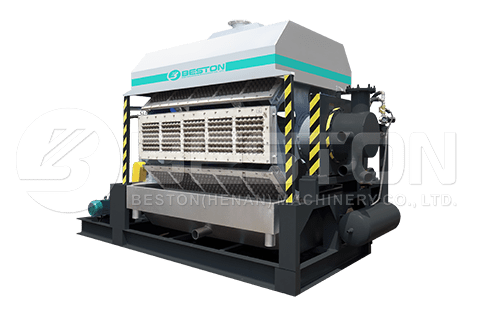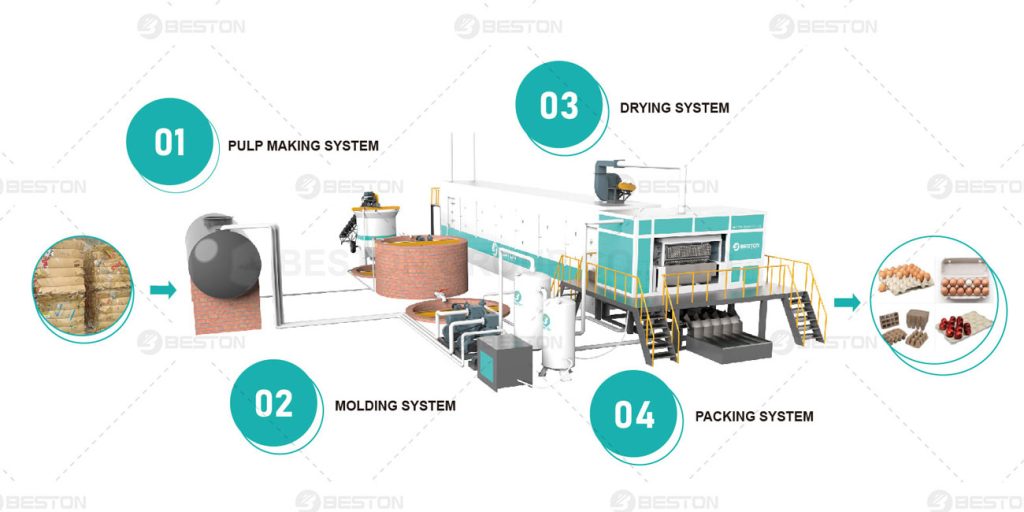From Raw Materials to Finished Products: The Production Process of an Egg Tray Machine
The production of paper egg trays is a multi-step process that converts raw materials, such as recycled paper, into functional, biodegradable packaging. An egg tray machine plays a critical role in this transformation, automating various stages of production to ensure efficiency, consistency, and product quality. This article outlines the step-by-step process involved in converting raw materials into finished egg trays using an egg tray machine.

1. Raw Material Preparation
The production process begins with the selection of raw materials, typically consisting of waste paper, cardboard, or other fibrous materials. Recycled paper, being both cost-effective and eco-friendly, is commonly used for its biodegradability and ease of sourcing. The first step in the process is to shred the paper into smaller pieces. This ensures that the fibers are easier to break down during pulping, which is a crucial step for creating the pulp slurry used in tray formation.
The shredded paper is then soaked in water to soften the fibers, making them easier to process. This mixture of water and paper forms a pulp, which is the foundational material for egg tray production. The consistency of the pulp is critical, as it must be thick enough to hold shape but not so dense that it impairs molding. The pulp preparation stage is essential for ensuring the quality of the final product.
2. Pulping and Refining
Once the raw materials are soaked, they are transferred to a pulping machine where the fibers are broken down into a slurry. This slurry typically consists of 99% water, which is mixed with the shredded paper pulp. The egg tray machine uses mechanical agitation to further refine the pulp and ensure uniform consistency. In this stage, the pulp is often screened to remove larger particles and ensure a smooth texture that will produce even trays.
Pulping is a critical part of the process because the quality of the pulp directly affects the strength and durability of the egg trays. An under-refined pulp mixture can result in weak trays, while an overly refined pulp may lead to difficulties during molding. Therefore, the egg tray machine must maintain a delicate balance during this step.
3. Molding Process
The next step in the production process is molding. Once the pulp is ready, it is fed into a series of molds within the pulp molding machinery. The machine uses vacuum pressure to pull the pulp slurry into the molds, which are typically designed in the shape of egg trays. The molds are often made of metal or plastic, and their design ensures that the trays will have the correct dimensions to securely hold eggs.
The vacuum-assisted molding process ensures that the pulp forms uniformly and accurately within the mold, minimizing the risk of defects in the final product. At this stage, the egg tray machine precisely controls the amount of pulp deposited into each mold to avoid overfilling or underfilling, which could result in substandard trays.
4. Drying
After molding, the next essential step is drying. The pulp-filled molds are transferred to a drying area, where the trays are subjected to heat to remove excess moisture. The drying process is crucial, as undried trays will lack structural integrity and may deform during handling. An efficient egg tray machine uses a combination of natural air drying, heated air, or even infrared technology to speed up the drying process while ensuring uniformity. The egg tray making machine price varies from different drying methods.
Some egg tray machines utilize drying tunnels equipped with air blowers or conveyor systems to increase drying efficiency. In modern machines, heat recovery systems are integrated to reduce energy consumption and minimize waste during this stage. Drying times may vary depending on the type of machine and environmental conditions but generally range from a few hours to an entire day, depending on the volume of production.
5. Stabilization and Inspection
Once dried, the paper egg trays are removed from the molds and undergo a brief stabilization period. This step ensures that any residual moisture is completely evaporated, and the trays reach their final form. After stabilization, the trays are inspected for defects, such as uneven shapes, cracks, or weak points. If any issues are detected, the trays are either reprocessed or discarded.
To ensure consistency, the egg tray machine may include an automated inspection system that checks for imperfections, enabling faster identification and quality control. This reduces the likelihood of defective products reaching the market and helps manufacturers maintain high-quality standards.
6. Packaging and Distribution
The final step in the production process involves packaging the finished egg trays for distribution. Once inspected and approved, the trays are stacked, bundled, and wrapped for transport. Depending on the scale of the operation, the paper tray making machine may be connected to an automatic packaging system that further streamlines this stage. Finished egg trays are then shipped to egg producers, retailers, or wholesalers, where they are used for packaging eggs or other products.
Conclusion
The production of paper egg trays, from raw materials to finished products, involves a precise and well-coordinated process. An egg tray machine automates key stages such as pulping, molding, and drying to ensure high efficiency, product consistency, and sustainability. By utilizing recycled paper and adopting energy-efficient drying technologies, modern egg tray machines provide a more environmentally friendly solution to traditional plastic egg cartons. The result is a biodegradable product that meets both the practical and environmental demands of the packaging industry.
